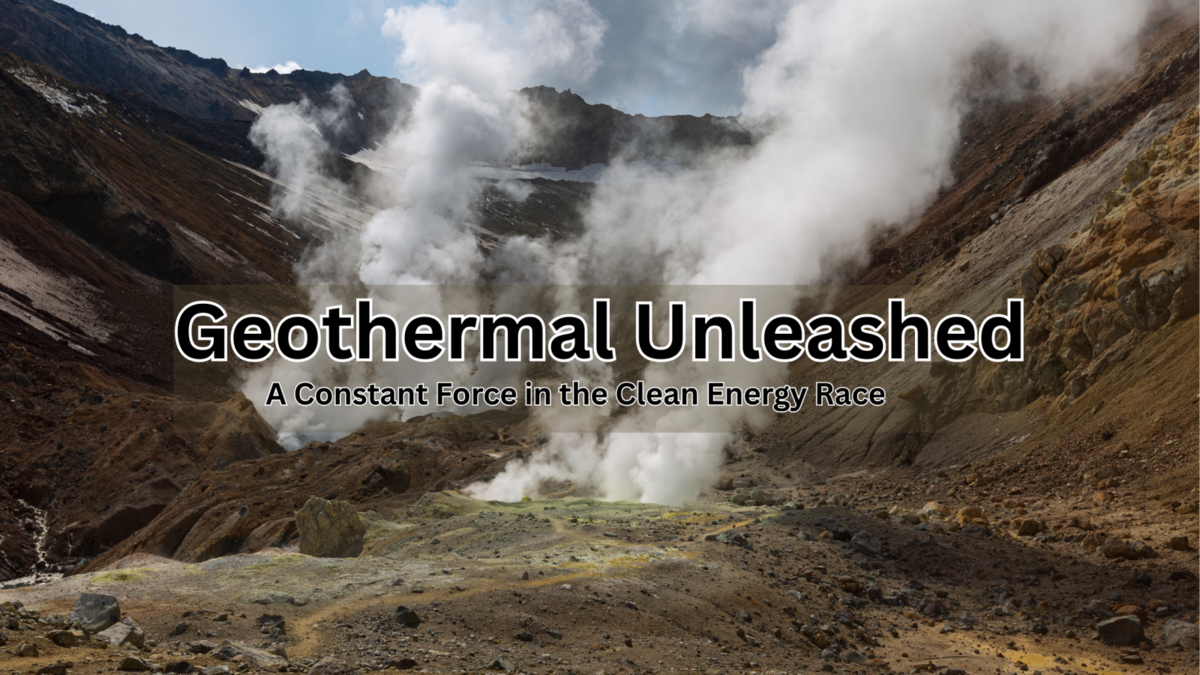In the race to shift towards cleaner energy sources, geothermal energy is becoming one of the strongest options. Even though it is hardly given the same level of importance as solar and wind, geothermal power is a versatile and robust source of low-emission electricity and heat.
From technological innovation to grassroots movements and increasing funding, in this blog, we will look into how geothermal energy is coming to life. The possibilities of this energy source look bright, and with all the clean energy slumbering beneath the Earth’s surface, it is time to be enthusiastic.
Unlocking Geothermal Potential: A Game-Changer for Clean Energy
Geothermal energy is regarded as one of the most under-appreciated yet highly valuable alternative energy resources. It uses steam to generate electricity by tapping into the heat stored beneath the Earth’s crust. For a long time, Iceland, Indonesia, and the United States were the only countries able to utilize geothermal resources because of pre-existing infrastructure. Recent technological advancements, however, have seemed to ease this burden.
Unlocking the true capabilities of geothermal energy lies within the development of Enhanced Geothermal Systems (EGS). These systems employ sophisticated drilling and fracturing methods to reach higher temperature geothermal resources, usually over 3 kilometers deep. The combination of EGS technology with horizontal drilling and hydraulic fracturing is opening new frontiers to the development of geothermal energy in places that were thought to be economically unfeasible. EGS alone could make it possible to produce geothermal energy at up to 140 times the current oil energy output, according to the International Energy Agency (IEA). What’s more, the world can expect an increase in supply for lower prices.
This shift could help stabilize the ever-increasing demand for electricity as the IEA estimates next-generation geothermal systems will be able to fulfill about 15% of the world’s electricity needs by 2050, equating to 8006 gigawatts (GW) of geothermal capacity. This would produce almost 6,000 terawatt-hours (TWh) of electricity per year, equivalent to the combined electricity demand of the United States and India. These advancements position geothermal as a serious contender to meet global clean energy goals.
A Versatile, Clean, and Secure Source of Energy
One of the key advantages of geothermal energy is its ability to provide dispatchable power—energy that is available on demand. Unlike solar and wind power, which depend on weather conditions, geothermal energy can provide a steady, continuous supply of electricity 24/7. This makes geothermal a highly reliable energy source that can support grid stability, particularly as the world shifts towards more intermittent renewable sources. In 2023, geothermal capacity operated at a utilization rate of over 75% globally, significantly outperforming wind (30%) and solar PV (15%) in terms of efficiency (IEA, 2025).
This reliability means that geothermal power plants can run at maximum capacity around the clock, ensuring that electricity is available whenever it’s needed. This makes geothermal particularly well-suited to balancing out the variability of solar and wind energy, providing a stable base-load power supply that can help integrate intermittent renewables into the grid.
Geothermal energy is also highly versatile. It’s not just used for electricity generation—geothermal heating is an important application, especially in the building and industrial sectors. Geothermal can provide district heating to entire cities or industrial complexes, reducing the reliance on fossil fuels for space heating. This is a key benefit in areas where the demand for heating is high, particularly in colder regions. By tapping into geothermal resources for both power and heat, countries can decarbonize multiple sectors simultaneously.
Geothermal Heating and Cooling: A Community-Centered Revolution
One of the most exciting developments in the geothermal space is the Community Geothermal Heating and Cooling Initiative (CommGeo), launched by the U.S. Department of Energy (DOE). This initiative is breaking new ground by focusing on empowering communities to decide their energy futures. The CommGeo program provides funding to communities to develop and implement geothermal heating and cooling systems, with a particular emphasis on community-driven engagement and collaboration.
Through this initiative, the DOE is supporting five communities to install geothermal heating and cooling systems, often referred to as Thermal Energy Networks. These systems distribute geothermal energy for heating and cooling over a wide area, such as a district or municipality, reducing energy costs and providing cleaner alternatives to traditional systems.
The five selected communities are a mix of urban, suburban, and rural locations, ensuring that diverse project sizes, technologies, and challenges are addressed. Notable project locations include Ann Arbor, MI, Chicago, IL, and Framingham, MA, each of which is implementing its unique geothermal solution. These initiatives will serve as models for other communities, demonstrating how geothermal can be scaled up and integrated into local energy systems to reduce costs, improve energy security, and boost grid resilience.
By involving community stakeholders, such as local residents, installers, and government representatives—these projects are designed to meet the specific needs of each community while also fostering shared learning and collaboration. The DOE has created a Community of Practice where representatives from the selected coalitions can share their experiences and best practices, promoting collaboration and innovation across the geothermal sector.
Global Investment and Market Potential: The Future Looks Bright
Geothermal energy is rapidly attracting attention from governments, utilities, and the private sector. Global investment in geothermal is expected to grow significantly in the coming years. By 2035, total investment in geothermal could reach USD 1 trillion, with the potential to double to USD 2.5 trillion by 2050. This growth is driven by the increasing need for low-emission energy sources to meet rising demand, particularly in sectors like electric vehicles, data centers, and industrial applications.
Geothermal’s growing market potential is particularly evident in regions with rapidly rising electricity demand or those looking to reduce reliance on coal-fired power. Countries like China, India, and the United States have the largest geothermal market potential, accounting for three-quarters of the global total. As the cost of geothermal technologies continues to fall due to economies of scale and technological advances, geothermal energy is becoming more competitive with other renewable sources like solar and wind.
The recognition of geothermal’s advantages by a growing number of societies and institutions is likely to have a large scale impact on achieving climate related aims. The capability of geothermal energy to provide constant and non-polluting power makes it critically important for the vision of a future energy system that has undergone decarbonization.
The Role of the Oil and Gas Industry: A Natural Transition
Unlike most renewable energy sources, geothermal energy has the advantage that its development requires expertise and advanced technology, which the oil and gas industry has. Some 80% of the costs associated with geothermal projects contain skills, capacity, and technologies that exist in the oil and gas industry. This covers drilling and well completions as well as a range of analyses known as subsurface data analysis.
Moreover, the aggressive, efficient resources of the oil and gas industries assist in progressive technology-driven initiatives for geothermal projects, which aid in reducing the cost and time for project initiation. The initiative will also provide the oil and gas industry with other sources of income through the increasing market for clean energy technologies while maintaining the benefit against future declines in demand for fossil fuels.
Furthermore, the oil and gas industry’s expertise in managing large-scale infrastructure and supply chains can accelerate the deployment of geothermal projects, bringing them to market faster and more efficiently.
Challenges Ahead: Overcoming Regulatory and Workforce Hurdles
Geothermal energy is a good example of renewable energy that can provide clean energy to help mitigate climate change. However, it still has not reached its full potential as a geothermal resource due to the obstacles associated with it. One of the major challenges is the permitting and regulatory practices frameworks; some projects can take up to 10 years to commission! It is due to the large amount of paperwork, such as the environmental assessment and regulatory body interaction, that is necessary. In any case, it is important that governments remove the barriers for permitting processes to geothermal development, implement dedicated regimes, and geothermal-specific legislation.
A lesser-known barrier but equally as threatening due to the high demand is the workforce gap. The current workforce is primarily composed of individuals who were previously employed in oil and gas; without a shift of focus to industry recruitment, a skilled workforce for the needed future positions will not be available.
Investing in training, higher education and internships at a younger age is the solution that policy makers and business decision makers need to act on to ensure a sustainable workforce.
Why Geothermal Energy Deserves Your Attention
When it comes to obtaining sustainable and clean energy, geothermal energy performs optimally. With features such as consistent and dependable energy generation and whole community heating, cooling, and electrification, it is clear that geothermal energy will be integral in the future global energy transition.
Geothermal has the potential to become one of the most important sources of renewable energy in the coming decades if there is ongoing technological advancement, investment, and policy support. Every step taken towards getting more governments and companies to adopt this resource pushes us to a cleaner and more sustainable future.
References:










